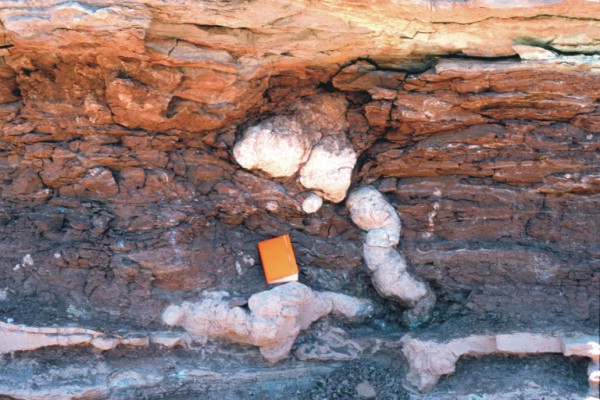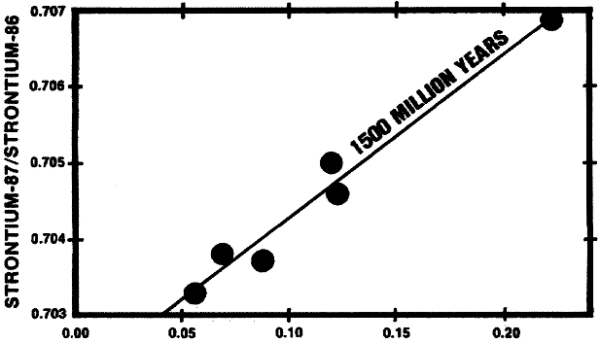That's just a few percent of deviation, and perfect results cannot be expected in first instance. This does not cast doubt on the validity of the method.O.K., first thing I noticed with the correlation between the varves is there are
many points where the C14 dated layers are off by 200 to 600 years (and
that's of the dates that were accepted as valid by the researchers).
Second, varve analysis is a rough guess at best:
Furthermore, if the method is so unreliable as you want to make it appear,why do the varves of two different lakes in two different places of the earth agree with each other? There is no reason why that should be so
Hardly. It's an extrapolation which of course isn't perfect, but calling it "a rough guess" is great exaggeration.Second, varve analysis is a rough guess at best:
IS there anything which indicates that they changed in the past? How about things which indicate that the decay rates did not change, such as the oklo reactor or supernova 1987N? Why would all decay rates be affected in a way so that they still produce correlating results?Uranium-Thorium dating is subject to the same assumptions as C14
dating...uniformitarian interpretation of the decay rates.
Initial presence of daughter materials is equivalent in effect to contamination. Both can be detected with isochron dating methods.Another particularly troublesome aspect of the technique is the requirement
for the object to be dated- it must take up uranium-238 and no thorium,
then immediately be closed off so it would not be able to take in more.
To me, that's very unrealistic.
The assumptions that each of these radiometric dating methods make are:
1. Each system has to be a closed system; that is, nothing can contaminate
any of the parents or the daughter products while they are going through
their decay processâ€â€or the dating will be thrown off. As we've discussed in
previous posts, there's no such thing as a closed system...except the
universe itself.
2. Each system must initially have contained none of its daughter products.
But how do you confirm this?
No interaction of neutrinos with decay rates is known, as far as i know.3. The process rate must always have been the same. The decay rate must
never have changed. I think this is extremely unrealistic, which is why i only
use C14 as a relative dating tool...not absolute. The decay rate of any
radioactive mineral can be altered [1] if the mineral is bombarded by high
energy particles from space (such as neutrinos, cosmic rays, etc.); [2] if
there is, for a time, a nearby radioactive mineral emitting radiation; [3] if
physical pressure is brought to bear upon the radioactive mineral; or [4] if
certain chemicals are brought in contact with it.
Radiation also has very little effect on decay rates. Neutron capture is known to be able to put the decay rate of beryllium (the most sensitive isotope in this regard) off by no more than less than 1%. In order to account for a young earth it however would have to put it off by 100,000,000%! And that still would leave the problem of excess energy - compressing 5 billion years worth of nuclear decay energy release into 6000 years would turn the earth into a ball of molten slag at best, more likely a plasma ball. It's the current "slow" decay which keeps the inside of the earth molten - imagine what happens if the energy release rate is increased by a factor of 1,000,000!
That's just wrong.4. If any change occurred in past ages in the blanket of atmosphere
surrounding our planet, this would greatly affect the clocks in radioactive
minerals.
...which still cannot even nearly account for the required change of the decay speed, as that's exactly what was tested with the beryllium decay - a low percent value. Furthermore, the surface of the earth being exposed to radiation like that would utterly sterilize it, and it'd be quite detectable today just like the surrounding of tchernobyl will still be radioactive in thousands of years - and the intensity of radiation that you propose would have been many many orders of magnitude higher than that of tchernobyl...5. The Van Allen radiation belt encircles the globe. It is about 450 miles above us and is intensely radioactive. According to Van Allen, high-altitude tests revealed that it emits 3000-4000 times as much radiation as the cosmic rays that continually bombard the earth.
Any change in the Van Allen belt would powerfully affect the transformation
time of radioactive minerals.
Again, isochron dating detects this in very most cases, and the mechanism which removes daughter products from lava flows is well understood.6. A basic assumption of all radioactive dating methods is that the clock had
to start at the beginning; that is, no daughter products were present, only
those elements at the top of the radioactive chain were in existence.
Is there any reason to assume initial apparent age, i.e. a deceitful creator?7. This factor of initial apparent age would strongly affect our present
reading of the radioactive clocks in uranium, thorium, etc.
No - if the dating methods were flawed in the way that you suggest we should not see correlation. E.g. the effect of radiation would vary greatly depending on the location of the sample, due to exposure of different intensity of radiation. And other independent methods which are not affected by radiation shouldn't agree to those methods at all then. Eevn if e.g. nuclear decay was twice as fast for all isotopes everywhere on earth in the past , there is no reason whatsoever why completely independent methods such as varves should be put off by the precisely same factor.So in summary, you can have different radiometric dates correlating for a particular sample or between samples, but their still giving you relative
results, not absolute.
Furthermore there is sufficient indication that the decay rates did not change in the past in first instance...there is no way how you can explain that away without a change of natural constants such as the speed of light, and other incredibly fine tuned changes to other casually unrelated constants which make any signs of these changes disappear.
That happening by coincidence (especially in a universe ruled by a God) is extremely unlikely, it's safe to say that this didn't happen beyond reasonable doubt. I see no way to reconcile this with an desired age of the earth which is off by a factor of about a million.
The assumptions however have been checked and verified.To make all the assumptions given above for the dating to be correct is not reasonable in my opinion.
Do you not agree that an old earth is a very good explaination of all these things?
One of the links (the one which included fossilized riverbeds, results of slow erosion of limestone, in strata which supposedly was laid down by the flood during a single year) was written by Glenn Morton, a former young earth creationist and now theistic evolutionist. He has a formal education in geology and saw no way to reconcile the data which he worked with with a young earth. If the dating methods were so obviously flawed as you suggest, don't you think he would have retained his stance on these matters?































